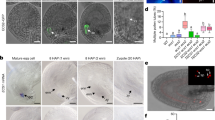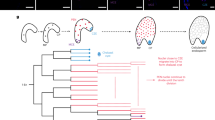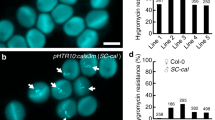Abstract
CYTOCHEMICAL investigations and examination by electron microscopy of developing anthers in Tradescantia bracteata reveal that exine proper develops at a time when the microspores are separated from the tapetum by the callose walls of the tetrad. The bulk of exine is produced at an early stage, and at the time of release of microspores from the tetrads it has attained a pattern very similar to that seen at maturity. We have found no evidence to support the view that sporopollenin is produced by mitochondria1, nor have we observed Ubisch bodies or sporopollenin deposits in the tapetum of this plant at any stage, as have been reported in a number of other species1–3. Six days after break-up of the tetrads, when the deposition of intine has begun, channels 20–40 mµ in diameter can be seen traversing the endexine from the pollen surface to the intine. Between the intine and endexine, tubular structures believed to be sites of sporopollenin polymerization can be seen in a plane perpendicular to the long axis of the pollen grain. In tangential sections through the exine itself it often appears split into parallel bands of fibrils again perpendicular to the long axis of the pollen grain (Fig. 1a and b).
This is a preview of subscription content, access via your institution
Access options
Subscribe to this journal
Receive 51 print issues and online access
$199.00 per year
only $3.90 per issue
Buy this article
- Purchase on Springer Link
- Instant access to full article PDF
Prices may be subject to local taxes which are calculated during checkout
Similar content being viewed by others
References
Heslop-Harrison, J., in Pollen Physiology and Fertilisation (edit. by Linskens) (North Holland, 1964).
Ubisch, G. V., Planta, 3, 490 (1927).
Kosmath, L., Osterr. Bot. Z., 76, 235 (1927).
Maheshwari, P., Introduction to the Embryology of Angiosperms (McGraw-Hill, 1950).
Sachs, J., Text-Book of Botany (translated by Bennett and Thiselton-Dyer) (Oxford University Press, 1875).
Fischer, H., thesis, Berlin (1889).
Stanier, F., Huard, D., and Bronckers, F., Pollen et Spores, 9, 367 (1967)
Author information
Authors and Affiliations
Rights and permissions
About this article
Cite this article
MEPHAM, R., LANE, G. Exine and the Role of the Tapetum in Pollen Development. Nature 219, 961–962 (1968). https://doi.org/10.1038/219961a0
Received:
Revised:
Issue Date:
DOI: https://doi.org/10.1038/219961a0
Comments
By submitting a comment you agree to abide by our Terms and Community Guidelines. If you find something abusive or that does not comply with our terms or guidelines please flag it as inappropriate.



